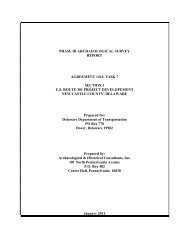Gulph Creek Stone Arch Bridge - Delaware Department of ...
Gulph Creek Stone Arch Bridge - Delaware Department of ...
Gulph Creek Stone Arch Bridge - Delaware Department of ...
You also want an ePaper? Increase the reach of your titles
YUMPU automatically turns print PDFs into web optimized ePapers that Google loves.
Chapter 3—Historic Context for Common Historic <strong>Bridge</strong> Types<br />
3.2.7 Steel Tied <strong>Arch</strong><br />
History and Description: Steel arches can be fixed, hinged, or tied. Tied steel<br />
arches, also commonly referred to as “tied thru (or through) arches,” are descendents <strong>of</strong><br />
the iron “bowstring” trusses (discussed in Section 3.1.6) that were patented in the midnineteenth<br />
century.<br />
Structurally, the advantage <strong>of</strong> the steel tied arch is that they do not require large<br />
abutments to counter the thrust <strong>of</strong> the arch action. Abutments could be smaller and more<br />
economic. A tied arch span has a structural element, usually a floor system, which ties<br />
the ends <strong>of</strong> the arch together. According to the FHWA <strong>Bridge</strong> Inspector’s Training<br />
Manual, a tied arch is a variation <strong>of</strong> a through arch in which the horizontal thrust <strong>of</strong> the<br />
arch reactions is transferred to the horizontal tie, which acts in tension. The bowstring<br />
arch is essentially a tied arch expressed in metal, but not all metal tied arches should<br />
necessarily be characterized as bowstrings. The arch members are called ribs and can be<br />
fabricated as beams, girders or trusses, and can be further classified as solid rib, braced<br />
rib, or spandrel braced. The arch members can be riveted, bolted or welded together<br />
(23, p. 8.8.3).<br />
Lengths vary from 30 to 50 feet for the short spans. The shorter spans were<br />
predominately constructed in the 1930s. An early steel tied-arch bridge is the Franklin<br />
Street <strong>Bridge</strong> (1939) spanning Oil <strong>Creek</strong> in Crawford County, Pennsylvania. In its<br />
modern form, tied arches have been designed for spans ranging from 180 feet to over 900<br />
feet. The longest steel tied-arch bridge in the United States is the 912-foot long<br />
Moundsville <strong>Bridge</strong> (1986) over the Ohio River in Marshall County, West Virginia.<br />
Significance Assessment: The tied steel arches built before 1955 (the end <strong>of</strong> the<br />
historic period covered in this study), many dating to the second quarter <strong>of</strong> the twentieth<br />
century, are notable bridge structures because <strong>of</strong> their distinctive arch form. They were<br />
not built in great numbers, thus examples that retain their character-defining features will<br />
possess significance within the context <strong>of</strong> this study. Character-defining features include<br />
the curved top girder or truss (ribs), suspenders, ties, the bottom chord and floor system.<br />
Examples <strong>of</strong> Steel Tied <strong>Arch</strong><br />
1. West End—North Side <strong>Bridge</strong> (1932), Allegheny County, PA. NRHP<br />
listed 1979.<br />
2. Franklin Street <strong>Bridge</strong> (1939), spanning Oil <strong>Creek</strong> at Franklin Street,<br />
Titusville, Crawford County, PA. HAER PA-494.<br />
3. Braceville <strong>Bridge</strong> (1939), spanning Southern Pacific Railroad tracks at<br />
State Route 129, Braceville vicinity, Grundy County, IL, HAER IL-141.<br />
4. I-95 <strong>Bridge</strong> over Myrtle Avenue (1955), Jacksonville, FL. Considered<br />
NRHP eligible in Historic Highway <strong>Bridge</strong>s <strong>of</strong> Florida (2004).<br />
5. Blue River <strong>Bridge</strong> (1933), Jackson County, MO. Listed as NRHP eligible<br />
in Missouri Historic <strong>Bridge</strong> Inventory (1996).<br />
6. John McLoughlin <strong>Bridge</strong> (1933), Oregon 99E, spanning Clackamas River,<br />
Oregon. NRHP eligible 1985. HAER OR-67.<br />
3-69






